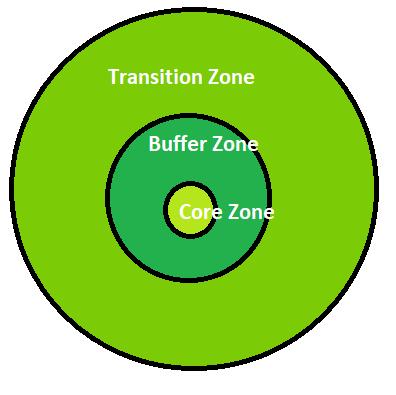
Answer
388.2k+ views
Hint: Biosphere reserves are referred to as "learning environments for sustainable development". Each site encourages methods that balance biodiversity conservation with long-term use. National governments nominate biosphere reserves, which remain within the sovereign jurisdiction of the states in which they are located.
Complete Answer:
Each biosphere reserve is designed to fulfil three main roles that are mutually reinforcing and complementary:
Contribute to the conservation of landscapes, ecosystems, species, and genetic variation through biodiversity conservation.
Sustainable Growth — To promote socio-culturally and environmentally sustainable economic and human development.
Support for Logistics – to help with research, monitoring, education, and information sharing on local, national, and global conservation and development challenges.
Protected areas are included in the core area because they serve as benchmarks for the natural state of the ecosystems represented by biosphere reserves. These core areas' data can be used to determine the long-term viability of operations or the preservation of environmental quality in the surrounding areas.
Buffer zone: a zone that surrounds or is next to the main region. The activities are planned in such a way that they do not obstruct the core area's conservation goals, but rather aid in their protection. The buffer zone could be a testing ground for new ideas, or it could be a place where natural vegetation, agricultural land, woods, fisheries, or ranchland are managed to improve overall production quality while preserving natural processes and biodiversity.
The broad outside area of a reserve where people live and work while exploiting the natural resources of the area in a sustainable manner is known as the Transition Zone or Area of Cooperation. Local communities, conservation agencies, scientists, civil associations, cultural groups, corporations, and other stakeholders come together here to commit to work together to manage and use the region in a sustainable manner that benefits everyone.
So, the correct answer is option C.

Note:
The World Network of Biosphere Reserves currently has 714 biosphere reserves in 129 nations, including 21 transboundary sites. Out of which 18 are in India. The first biosphere reserve, Nilgiri Biosphere Reserve, was created in 1986 across Tamil Nadu, Kerala, and Karnataka.
Complete Answer:
Each biosphere reserve is designed to fulfil three main roles that are mutually reinforcing and complementary:
Contribute to the conservation of landscapes, ecosystems, species, and genetic variation through biodiversity conservation.
Sustainable Growth — To promote socio-culturally and environmentally sustainable economic and human development.
Support for Logistics – to help with research, monitoring, education, and information sharing on local, national, and global conservation and development challenges.
Protected areas are included in the core area because they serve as benchmarks for the natural state of the ecosystems represented by biosphere reserves. These core areas' data can be used to determine the long-term viability of operations or the preservation of environmental quality in the surrounding areas.
Buffer zone: a zone that surrounds or is next to the main region. The activities are planned in such a way that they do not obstruct the core area's conservation goals, but rather aid in their protection. The buffer zone could be a testing ground for new ideas, or it could be a place where natural vegetation, agricultural land, woods, fisheries, or ranchland are managed to improve overall production quality while preserving natural processes and biodiversity.
The broad outside area of a reserve where people live and work while exploiting the natural resources of the area in a sustainable manner is known as the Transition Zone or Area of Cooperation. Local communities, conservation agencies, scientists, civil associations, cultural groups, corporations, and other stakeholders come together here to commit to work together to manage and use the region in a sustainable manner that benefits everyone.
So, the correct answer is option C.

Note:
The World Network of Biosphere Reserves currently has 714 biosphere reserves in 129 nations, including 21 transboundary sites. Out of which 18 are in India. The first biosphere reserve, Nilgiri Biosphere Reserve, was created in 1986 across Tamil Nadu, Kerala, and Karnataka.
Recently Updated Pages
Class 10 Question and Answer - Your Ultimate Solutions Guide

Master Class 10 Science: Engaging Questions & Answers for Success

Master Class 10 Maths: Engaging Questions & Answers for Success

Master Class 9 Social Science: Engaging Questions & Answers for Success

Master Class 10 General Knowledge: Engaging Questions & Answers for Success

Master Class 10 Social Science: Engaging Questions & Answers for Success

Trending doubts
Pigmented layer in the eye is called as a Cornea b class 11 biology CBSE

Proton was discovered by A Thomson B Rutherford C Chadwick class 11 chemistry CBSE

What organs are located on the left side of your body class 11 biology CBSE

The lightest gas is A nitrogen B helium C oxygen D class 11 chemistry CBSE

How many squares are there in a chess board A 1296 class 11 maths CBSE

What are ekaboron ekaaluminium and ekasilicon class 11 chemistry CBSE




